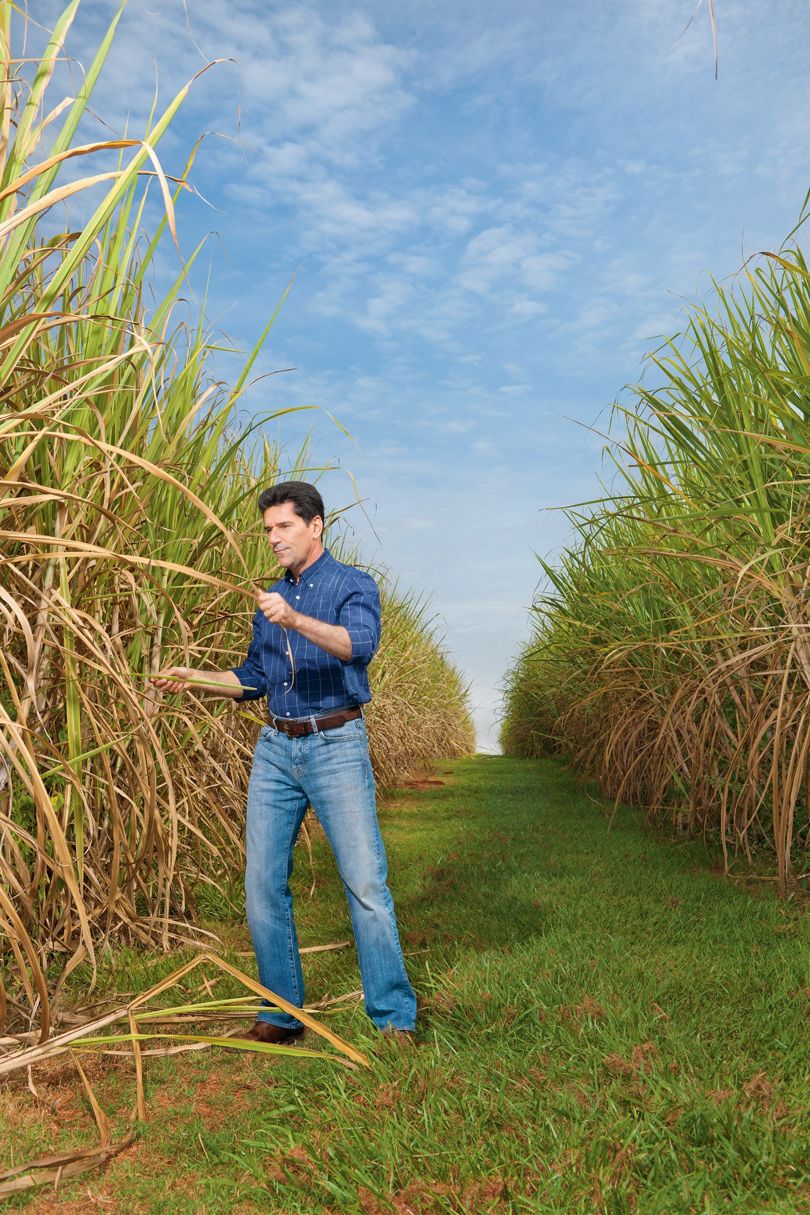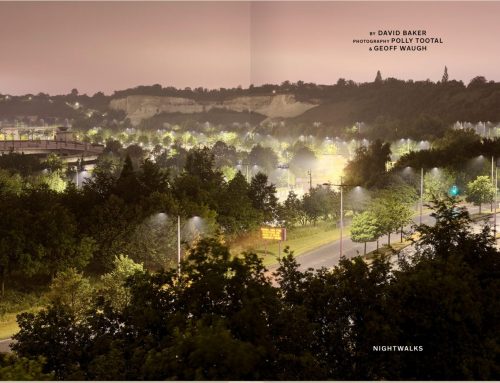Leontino Balbo Junior’s green farming future
Wired, August 2013
At the end of 2004, Leontino Balbo Junior, executive vice-president of the Balbo Group, Brazil’s biggest organic-sugar grower, gave over 100 hectares of the company’s land to a sugarcane variety called SP84-2025. Variety SP84-2025 had had a chequered history. Initially a robust and productive crop which had proved ideal for the fertile plains of São Paulo state, by the late 90s it had become susceptible to yellow-leaf virus, which had not only reduced its productivity but had also threatened to contaminate adjacent fields. Weakened and commercially useless, it was abandoned by the industry in 2003 and consigned to the scrapheap of crops gone bad.
Balbo chose SP84-2025 to make a point. Since 1986, he had been working on a new form of agriculture that he was convinced would increase a crop’s productivity, boost its resistance to pests, reduce the resources needed to cultivate it, and broaden the biodiversity of the land in which it was grown. He called his approach “ecosystem revitalising agriculture” (ERA) and claimed that it could revive not only ailing crops, such as SP84-2025, but also ailing land that had been “starved of vitality” by decades of modern farming. If it was successful, the impact would be felt far beyond agriculture. “My aim, since I started that work,” he explains in the low-key cluster of buildings that make up the Balbo Group’s admin centre in Ribeirão Preto, 350km north-west of São Paulo, “has been to achieve agricultural self-sufficiency, a way to preserve the natural resources we need now — water, soil fertility, biodiversity and the atmosphere. Otherwise, we won’t be able to maintain a civilised society. If we have a water crisis, for example, we will end up having a global war because of natural resources. And human beings as a civilisation will be gone.”
It’s a Saturday, a few weeks before this year’s harvest is due to begin, and the Balbo offices are deserted. The company was founded in 1946, although the family has been in the sugar business since 1903, and its administrative buildings feel as though they are in a time warp. The chairman’s office is still kitted out in 70s executive style — a huge desk, deep leather sofa and plenty of heavy onyx ashtrays. Except for a carefully arranged display of organic consumer products, the boardroom could be that of any small- to medium-sized car-parts manufacturer in the West Midlands.
The hectares of green sugarcane fields stretching off in every direction through the windows give the place an eerie sense of being lost to the modern world.
In one sense, Balbo himself is also from another age. Now 52, he is fit and enthusiastic — he begins each day with a workout, limits his alcohol intake and is an accomplished water-skier. He has a full head of black hair, which he is quick to point out “is not dyed”, and fixes you with an intensity when he talks. He is at the helm of one of the most successful organic-sugar producers in the world and can talk the science of modern agriculture. But his real laboratory is nature itself and the annual cycle of sowing, reaping, clearing and sowing that has always been the farmer’s lot.
Sugarcane is harvested once a year, with the plants left in the ground to grow again, usually for up to six or seven harvests.
Before he began his experiment, SP84-2025 was producing about 98 tonnes of cane per hectare. After he began to apply the various tools of ERA to the crop. And something remarkable happened: cane that before had shown the unmistakable signs of yellow virus — leaves that were blemished with pale streaks — grew taller, stronger and furthermore remained pest-free. And its productivity soared, to 156 tonnes per hectare. In subsequent years, despite the arrival in Brazil of the orange-rust fungus, to which SP84-2025 had also proved highly susceptible, the cane delivered yields well above average and off the scale for a crop that had largely been declared moribund. “It was something that had never been seen in the industry before,” Balbo says.
ERA is organic in its approach but, for Balbo, it goes much further than simply not using artificial pesticides or fertiliser.
At its core is a respect for soil. Farming has tended to treat soil more as a receptacle for water and nutrients than as something that makes an active contribution to plant growth. “Soil is not just a container,” he says, “it’s also the content of the ecosystem. It holds the biodiversity, both living and mineral, that’s essential for life. If the soil loses this function, all other things are compromised.” According to Balbo, modern agriculture damages soil in three ways. Farm machinery compresses it, making it less able to hold water; fertilisers upset its natural chemical balance; and monocrops reduce its biodiversity, which he sees as essential for healthy plants. “So much soil used for agriculture is dead,” he says. “We need to revitalise it, to restore the energy of its ecosystem.”
To do this, Balbo set aside 16,000 hectares of the family plantation and began to change how it was farmed. First to go was the decades-old habit of crop burning. Since the early 20th century, many sugarcane producers have started fires in their fields before harvesting. Crop burning eliminates pests and snakes, and burns the “trash” — the living and dead leaves — from the canes, which makes them easier to cut. Balbo says the environmental downsides of this approach, however, are significant.
“After burning, the cane releases a sugar melt, like honey, which drops down into the soil. So the harvesters have to cut and collect not only the cane, but the melt, which is full of soil. This has to be washed at the mill — we were using three million litres of water every hour just to do that. Burning the trash denies you the opportunity to return it to the soil as mulch.”
As an alternative to crop burning, Balbo spent five years, from 1988 to 1993, developing a mechanical harvester that would cut the cane “green”, that is with its leaves still on. He built a machine that cut the cane into pieces and fed them into a hopper where opposing currents of air stripped off the leaves and sprayed them on to the recently cut ground. Harvesting in this way, Balbo says, returns 20 tonnes of trash per hectare to the soil each year, restoring nutrients, especially nitrogen, and forming a mulch that helps keep weeds down.
To address the problem of compression, Balbo turned his attention to the tyres used by the farm’s trucks. “Farm equipment is heavy,” he says, “and wherever you drive you compress the soil, changing its geometric structure and reducing its ability to hold water. We now have ultrasoft tyres that we partially deflate before driving into the fields to reduce the impact on the soil.”
At first, the results were not good. Production levels fell and pests increased. But, after five years, multiple layers of trash began to feed an increasing biodiversity of micro and macro fauna, and the canes grew stronger. What began as a hypothesis — that restoring biodiversity to the soil would lead to stronger plants — was starting to be proven.
Balbo’s inspiration is rooted in his upbringing in the lush countryside of São Paulo state. “I would come home from school,” he says, “strip down to my shorts and ride my bike into the forest to go fishing. I would stand there in the pond, waist-high in water, with a fishing rod in one hand and a rock in the other, ready to fend off crocodiles. It was there where I first started to understand the complexity of the forest, a place where each living organism has a role, a function in helping the others grow.”
In 1980 he went to São Paulo State University to study agronomy. He was a conscientious student but was saddened, he says, by the number of his classmates who, after graduation, went to work for fertiliser companies rather than on the land. He decided to dedicate himself to increasing the vitality of the land he would farm, to returning its state as close as possible to that of the forest that surrounded it. “For me, the forest has always been my inspiration,” he says. “There, you see no monocrops. There, there are hundreds of organisms growing together. The toxins secreted by one plant are taken up and metabolised by another. I don’t like to use the word ‘balance’. That implies something static. Instead there is omeostasis, where the system regulates itself to the benefit of all the parts that grow in it. Trash from plants falls back down on to the ground, and the soil is a living ecosystem that nourishes everything that grows in it.”
A forest, though, is not a farm, and Balbo’s challenge was to find a way of replicating the self-sustaining ecosystem of uncultivated land, while still being able to harvest crops, an act which, in its very nature, removes nutrients and energy from the land. Returning trash to the fields as mulch went some way towards this, but he still needed another way of restoring nutrients to the soil and capturing the energy that the plants had absorbed from the Sun. He turned his attention to the byproducts of the sugar-production process itself.
At the estate’s mill in São Francisco (one of its three mills, the company has turned this one over to organic production) the liquid residue left over after the cane pulp is fermented is collected and sprayed back on to the fields, and dry matter is fed directly into a furnace, which produces 200 tonnes of steam per hour. Some of this is used to extract sugar from the cane. The rest of the electricity powers the mill and its associated buildings, with excess sold to the grid.
At the heart of Balbo’s approach is the principle that, if he can restore his soil to condition of that in the forest, nature will do the rest. But nature works slowly and, between 1992 and 2000, he had, he says, many sleepless nights and a lot of stress. “We weren’t getting good production figures and the environmental results took some time to return, because no one had done this before, I didn’t know exactly where the problem was — in the tyres or in the trash. It was difficult to understand what was linked to what in the environment.”
In 1991, the World Bank commissioned the Copersucar Technology Centre, part of a large co-operative to which Balbo belonged, to carry out independent tests on Balbo’s fields over five years. The aim was to investigate the possibility of using trash to produce electricity, but Balbo agreed on the basis that the researchers would bring a scientific eye to his new agricultural techniques. “I had a sense that I was doing the right thing,” he says, “but I needed outside verification.”
The outcome was a disaster. “Ninety percent of their conclusions were negative about the potential green-cane harvesting offered for a new production model,” he says. “It was depressing and frustrating. I was sure I was seeing good things happening in the fields, but they were PhDs in entomology, in geology and so on, and they were finding the opposite. I asked myself: should I listen to them or rely on my own deep feelings?” The “good things” he was seeing represented a small but perceptible increase in biodiversity in his fields. Areas that before had been sterile were now starting to show signs of life. And it was at the lowest point of the Copersucar research period, when he needed, he says, just to get away from the researchers, that he at last understood why biodiversity was so important.
“Whenever I felt down or confused, I would go into the forest. I noticed something interesting. A branch had fallen from a tree and leaf-cutter ants were cutting up the leaves and transporting the parts back to their colony. Right next to them were living leaves, on branches still attached to the tree, and the ants left them alone. Somehow the fallen leaves were telling the ants that they were dying and ready to be recycled and the ants were acting on that and leaving the healthy ones. From the ants, I learned that everything in nature has a function. Everything is doing something. You can’t just go into an ecosystem and apply insecticide and eliminate 30 or 40 species of insect, because they have a role there.”
Returning to his crops after the researchers had left, he noticed signs that ERA was working. Fungi started to grow in the layers of trash on the ground. “These hadn’t been there before,” he recalls. “Some worked to decompose cane trash. Others metabolised leguminous plants [beans and peas] we were using as rotation crops.” After them came earthworms and termites, churning the soil and making it looser, and increasing its water-holding capabilities. “The bugs, combined with using softer tyres, changed the geometry and the composition of the soil. We soon started to see a fourfold increase in water retention, a fivefold increase in resistance to erosion and a threefold increase in organic content,” he says.
The number of pests in the fields was falling too. One of the most serious a sugarcane farmer can face is a small herbivorous insect, Mahanarva fimbriolata. “We had a big problem with Mahanarva fimbriolata,” says Balbo. “Conventionally, you use pesticides, but we did nothing. We started to see the arrival of a fly, Salpinpogaster nigra, which is the bug’s predator.” When certain predatory insects became too numerous, a parasitic fungus would emerge that reduced their population count. The arrival of another sugarcane pest, a caterpillar called Diatraea saccharalis, was accompanied by that of a tiny wasp, Cotesia flavipes, which predates it. “By leaving all of the insects in place,” says Balbo, “we enabled nature to keep them under control.” ERA had finally arrived.
It has taken him 27 years, but balbo has not only improved cane production on his land. He has also increased its biodiversity far beyond fungi and wasps. The Balbo fields are now home to hundreds of forest animals including foxes, deer, capybara and armadillos, four types of big cat and countless bird and insect species. But he sees sustainability as something more than this, a philosophy that encompasses not only environmental concerns, but economic and social ones too. His business is doing well, producing 75,000 tonnes of organic sugar — 34 per cent of the world market and a figure he is planning to raise as demand increases — and 55,000m3 of organic ethanol each year from a crop of about 1.2 million tonnes of cane. His sugar is used in about 120 high-profile products from Green & Black’s chocolate to Yeo Valley yoghurt.
On the farm, energy use has fallen by half and, when the introduction of green-cane harvesting threatened the jobs of the manual labourers who had previously cut the crop, he ensured that they were retrained and found work elsewhere on the plantation. All Balbo employees now have access to welfare, medical and sports facilities, and low-cost housing.
Yet, despite the industrial scale of the operation he now runs, there is still something of the Mowgli in Balbo. “I draw my strength from the land and the plants and everything that is alive,” he says. “These canes are very happy. I can feel that.”
Not everyone in the precision world of modern agriculture is comfortable with this apparently unscientific approach. The literature is still split about the benefits of green-cane harvesting, let alone the much more radical techniques of ERA.
Balbo is passionately opposed to GM crops (“like giving a monkey a revolver”) and he agrees that much of what he did in the early days came from intuition. But, he says, the results now speak for themselves. “I felt from the start that, in the forest, the higher the diversity of plants and animals in an ecosystem, the higher the stability of that system. I saw that the ants were not eating living trees, and that meant to me that if I could bring the soil in my fields to the same condition of the soil in the forest, the ants wouldn’t eat my cane either. And it has worked. Since we transferred this production model from the forests to the cane fields, the cane has a higher stability, a higher production and we can get more cuts out of it. In fact, I am hoping we will soon never have to remove cane any more, as we have to now after six or seven cuts. It will become permanent.”
Those who have worked closely with him over the past two decades say he is more scientific than he, and his critics, make him out to be. “What he practises is phenomenology,” says Evaristo de Miranda, a senior researcher at Embrapa, Brazil’s state-owned agricultural-research centre in Brasilia, who has been following Balbo’s project for more than 20 years. “It’s what farmers have done for over 10,000 years. He observes, experiences, analyses, innovates and transforms. He knows, as a good agronomist, to ask the right questions. He interrogates nature all the time and nature responds. His advances are empirical, in the full sense of the term.”
Luis Fernando Guedes Pinto, an agronomist at Imaflora, which promotes sustainable agriculture in Brazil, agrees. “Leontino is one of the best agronomists I have ever met. He has a solid scientific and technical background. It looks like he doesn’t use a scientific method to test his ideas, but he does not do things randomly or without background and a clear objective. He works with hypotheses and tests them. And, even if he believes it is not science, it is.”
Balbo himself is careful to back up his claims with statistics.
Visitors to the company are often treated to a long presentation on rising crop yields, falling pest numbers and reduced use of natural resources that leaves little unsaid or unanalysed. (wired’s lecture lasted for five-and-a-half hours and comprised 503 slides.) He is thrilled with what he has achieved and evangelical about it, and is, in unguarded moments, a little puzzled that others don’t always share his vision.
Balbo’s challenge is not so much criticism of what he does but invisibility. “I don’t know anyone who doubts the techniques he is applying,” says Ricardo Abramovay, professor of economics at the University of São Paulo, who researches large-scale agriculture. “He has achieved what many consider impossible: a large continuous area occupied by a single product that still provides exceptionally favourable conditions not only for agriculture but also for wildlife.” The problem is that very few outside the sustainable-agriculture sector have heard of what his is doing.
That should change this year, as Balbo is taking his ideas out of his testbed in São Paulo state, into the wider world. To market his ideas, in the autumn, he will be launching Agros Fortis (based on the Latin for “strong fields”), a technology-transfer company that will help others adopt ERA. “My first and main concern is to offer an alternative production model to chemical systems,” he says. “For me, at this stage of my life, money comes second and it will be a consequence of having been useful though the application of the technology. I intend to charge growers a certain amount per hectare of land where the technology is applied, and find a way they can pay me back from the additional revenues that ERA will provide. It is not my goal, like some big corporations do, to make the growers dependent on the system or to add extra costs. This technology aims to make the growers independent again, after almost four decades of domination [by big business].”
In the meantime, his own sugar production continues to grow. He is hoping to turn his 16,000 hectares of organically certified fields into 22,000 hectares. Balbo is certain that ERA can be applied anywhere in the world. “Yes, even in deserts,” he says. “It just depends on how many resources you are going to mobilise.” But he has a long way to go: even conventional organic farming makes up only about one per cent of the world’s agriculture. The fertiliser companies can rest easy for a while.
And, like all good innovators, he feels there is plenty more he can still do in Ribeirão Preto. “All along it has been like I have been doing a 10,000-piece jigsaw puzzle and now I have about 100 pieces to go. We will be able to produce cane sugar at half the cost of conventional production today, providing all those environmental benefits and using a third of the resources. That’s what makes me so enthusiastic.”
He knows that the project’s scope is huge — “Sometimes this feels like too much for one man to do” — but insists that he won’t stop. “I always see things to improve, new things to try,” he says. “If you put your love into the construction of something and you are really dedicated to it, then there is no competitor for you.
I love so much what I do, the opportunity to help people to eat healthy products as well as contribute to the environment. I love it so much,” he says, pausing for a while to gaze once more at his lush fields of cane, “that I never get tired.”






